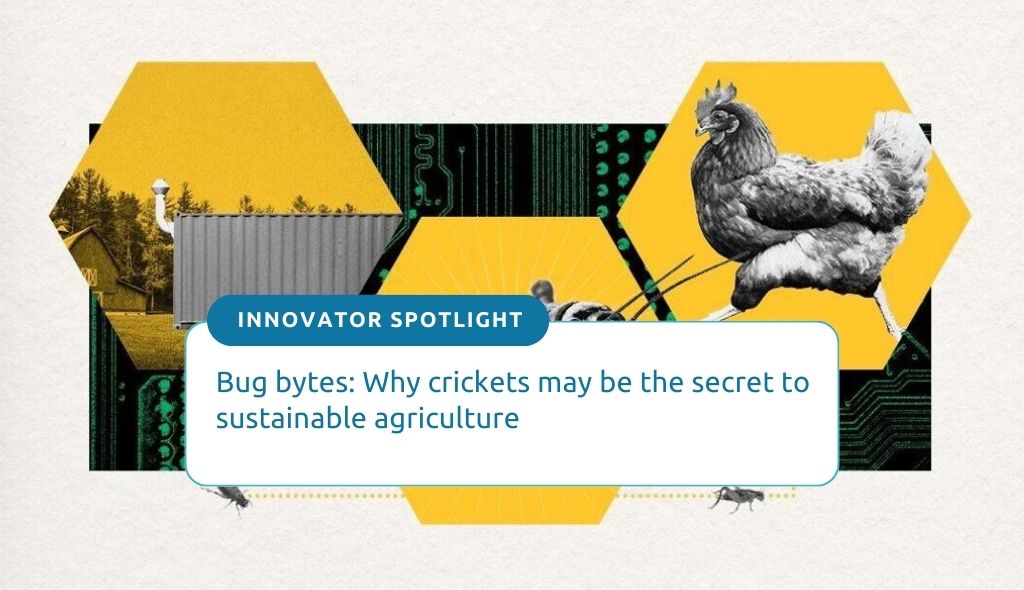To combat the outsized carbon footprint of livestock farming, the answer may lie in creatures with teeny-tiny feet.
A farmer’s hours are never 9–5, and Thorpe Farms is no exception. Sure, the chickens and turkeys are up and at ’em at the crack of dawn, but at this family-run operation in Odessa, Ont., the action can keep going all night (and all day) long. During the late summer and early fall, you can hear the commotion in a customized, food-grade shipping container on the 165-acre property, where as many as 350,000 of the farm’s tiniest residents can’t contain their ruckus. The noisemakers are crickets — specifically adult males wooing mates — and they (and their potential sweethearts) are being raised expressly to feed the livestock that Thorpe Farms’ owner, Cory Priest, also raises.
They are part of a uniquely hyperlocal food chain: Priest also grows vegetables, and the scraps from his veggie patch feed the crickets, which, once they mature, are gobbled up by Priest’s chickens and turkeys. The crickets, of course, also lay eggs, guaranteeing a more-or-less perpetual food supply. When baby crickets reach maturity, they are flash-frozen, then later thawed and fed to Priest’s chickens.
What makes the process even more unusual — and holds promise for many other farmers — is that this circle of life hinges on a high-tech system. The food container was customized by the Ontario startup Bug Mars and is outfitted with incubators and habitats. Eight separate cameras, as well as other sensors, are embedded within the container and collect data such as temperature, air quality, cricket movement, pest invasions. That data is sent to a tablet where Bug Mars’ proprietary platform processes it for Priest, who uses the knowledge to optimize the health and yield of his crop.
When Priest decided to become a farmer in 2008, his motivation was simple: He didn’t like the quality of the meat at the grocery store and thought he could do better. At the time, he was living in Kingston, Ont., where he worked as a welder and pipefitter. He and his wife, Shanna, had bought some vacant land in nearby Odessa with plans to retire there, and during summers, they began raising chickens and turkeys for their own consumption. After Thanksgiving dinner guests started raving about the meat, the Priests realized they could turn this hobby into a business. A decade and a half later, Thorpe Farms raises 3,000 chickens, 50 turkeys and 150 sheep each year. They currently supply a few restaurants and specialty stores and sell directly from the farm and their website.
Priest taught himself to farm through trial and error and many hours of YouTube. Much of this research was dedicated to maximizing profit. Priest’s animals are pasture-raised and grass-fed — “artisanal” is his preferred descriptor for his chickens — not a cheap approach, he notes. For example, it costs $24 to raise a chicken (not including the price of labour or fuel), with about $16 of that amount covering the grain the bird eats during its eight-week tenure on the farm.
Two and a half years ago, however, Priest stumbled across an intriguing way to cut costs while also reducing the carbon footprint of the feed and increasing its appeal for his animals. In 2021, he met Natalie Duncan, the co-founder of Bug Mars. Duncan, a visual artist with, as she puts it, “a lifelong interest in sustainable agriculture,” had spent a couple years experimenting with raising crickets as a food source in her own home. Insects are part of the traditional diets of at least two billion people around the world, but in North America, they have recently been touted as the food of the future. In 2014, Norwood, Ont.’s Entomo Farms started raising crickets to be sold whole and in powdered form, partnering within a few years with Loblaw and Maple Leaf Foods.
Proponents have emphasized the immense environmental benefits of bugs — crickets especially. Crickets have a better protein-to-calorie ratio than lean ground beef (60 calories gives you 10 grams of protein) and they only need a fraction of the water and land that cattle require. (For instance, it takes some 15,000 litres of water and 25 kilograms of feed to produce one kilogram of meat.) “Insect production is nowhere near as resource-intensive as livestock production,” says Emily Duncan (no relation), a researcher at the University of Regina who studies the impacts of digital technologies on agriculture.
But raising the insects isn’t easy. Four whole colonies died on Bug Mars’s Duncan, and when she talked to other cricket farmers, she discovered that this problem is fairly common. Large commercial farms like Entomo typically lose, on average, 50 per cent or more of their cricket crop to disease, fluctuating temperatures or humidity, even cannibalism. Along with her friend Seth Hardy, Duncan began researching solutions. They realized AI technology could be a boon for insect farms: cameras and other sensors could capture precise data about temperature, air quality, pests and so forth, and that data could provide operational knowledge to help farmers improve mortality rates and yields.
“The machine-learning does a couple of cycles,” Duncan says, “and then it can understand what’s happening on the farm and give real-time feedback, predictive analytics and recommendations.” Cricket farms typically hire entomologists to monitor environmental conditions and insect behaviour; this system would potentially replace that expertise and winds up being cheaper over time. In 2021, they founded Bug Mars to develop a marketable integrated software system.
By the time Bug Mars was founded, the insect trend had lost some of its lustre — you would have been hard pressed to find a bag of cricket powder on a mainstream grocery store shelf. But Bug Mars had its sights on different markets anyway. Alternative proteins were already a growing ingredient in pet food, and if North American consumers wouldn’t necessarily give up their chicken nuggets for cricket legs, what about the chickens themselves?
Bugs are a natural part of any chicken’s diet. There was, potentially, a massive market in poultry farms, especially in smaller, family-run ones, but also in aquaculture or cattle farms. (While cows don’t typically eat insects, they still require small amounts of protein — crickets can be blended into their usual feedstock.) “If it can be made profitable in comparison with other types of feed,” says Ian Mosby, a food historian and the co-author of the book “Uncertain Harvest,” “then that’s the real future, I think.”
Mosby and Emily Duncan both flag possible hurdles with Bug Mars’ agtech. There’s the accessibility and expense of system maintenance, for example, or the slim danger of crickets escaping into local ecosystems. Still, as the University of Regina’s Duncan notes, this approach could help farmers navigate supply-chain uncertainty and improve overall sustainability. “People always talk about agriculture being slow to change, and in some ways it is,” she says. “But it’s also a really cool place to experiment, to do things differently.”
Thorpe Farms is currently one of three pilot projects in the province testing the viability of the setup provided by Bug Mars (shipping containers, a colony, free software). There have been bugs to iron out — Priest’s birds prefer live crickets to dead ones, for example — but eventually, he expects to produce 400 pounds of crickets every month. And he’s convinced that other poultry farms will be quick to get on board with the technology. “If I can prove that it saves money, absolutely,” he says. “If I can input some apples and lettuce and get 400 pounds of protein at the other end for nothing, absolutely.”
Bug Mars currently has 150 other farms in Canada and the U.S. in its pipeline. Bug Mars’ software is subscription-based and a 500-foot-square farm using its platform retails for $7,200 a year. For Duncan, that cost is vastly outweighed by the economic and environmental benefits.
“Insects have been around longer than we have,” Duncan says. “We’re not introducing anything new to the world here. We’re trying to make it more affordable. If you don’t want to eat bugs, don’t eat bugs. But if you want to continue to eat meat, consider feeding your meat insects. Not only is it better for the planet, it’s better for the animals and it’s better for us.”






